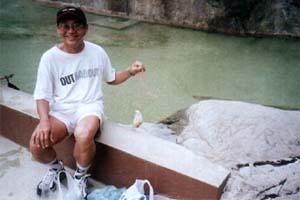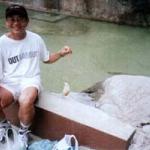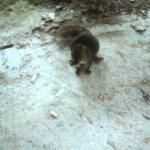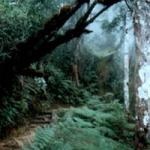It's Pouring in Poring Hot Springs
After a trek to the summit of Mount Kinabalu (4101 meters/13455 feet) there is no better place to visit than Poring Hot Springs. The sulfurous waters are believed by many to have a therapeutic effect on tired and distended muscles. The spring waters are also said to have skin-curative properties. It is heavenly bliss for weary mountain climbers to soak themselves in one of those individual-sized Japanese-styled tubs with millions of distant stars gazing down on them.
History
The Poring Hot Springs were developed by the Japanese invaders during the Second World War. In 1964 when Kinabalu Park was gazetted as a national park its 750 square kilometers (300 square miles) area included the Poring Hot Springs enclave. The authorities then decided to develop the area further as a Ranger station. Staff quarters were built in 1966 followed by visitor cabins and camp ground in 1967 and 1968.
In 1969 a beautiful suspension bridge was built across the Mamut River to allow visitors easier access to the hot springs from the office-cum reception and the accommodation facilities on the other bank of the river. Between 1970 to 1977 developments of Poring was put on hold due to uncertainty arising from the opening of the huge Mamut Copper Mine in the nearby higher lands which originally formed part of the Kinabalu Park but was de-reserved from the Park in 1971 and another piece of land the Mount Templer Forest Reserve added to Kinabalu Park. It was only towards the end of 1978 when it was found that the mine operations did not adversely affect the environment at Poring that development of additional visitor facilities, including the Serindit 1 Hostel (with 48-dormitory bunk beds) resumed in earnest. In 1979 a rock swimming pool, changing rooms and toilets were constructed at the hot and cold spring area. More bath troughs were added in 1980 and a new hostel the Serindit 2 with 24 beds were erected in 1982. The Rajawali Chalets (2 units) to house 6 persons were added later.
Geography
Poring lies 40 kilometers (25 miles) from the Kinabalu Park Headquarters. It is located on the southern fringes of the Park at the lowest part of the Park area at 550 meters (1805 feet). It is very easy to get to Poring from the Park Headquarters as there is a steady stream of vans taking visitors between the two points during the day. Moreover just outside the entrance of the Park headquarters is a bus stop. Stage buses plying regularly between the state capital city of Kota Kinabalu and Sandakan, Sabah's second largest town will drop and pick up passengers from this bus stop. The bus must stop at the next town Ranau, a market town. The 40-minute journey costs 5 Ringgit. In between the bus driver will drop off passengers or pick up new ones along the way at their convenience. Inside the bus foreigners of many nationalities and of different colors and creed sit comfortably cheek-by-jowl with the friendly local Chinese and natives with hues ranging from fair-complexioned to the brown-skinned. At the Ranau's market centre there will be many mini-vans waiting to pick up passengers to take them to outlying villages including Poring which is 19 kilometers (12 miles) north of Ranau. The mini-vans will stop right in front of the entrance of Poring Hot Springs Ranger station. The fare is also 5 Ringgit per head.
The journey between the Park Headquarters and Poring is very scenic and interesting. Travelers will pass vegetable (especially cabbage, Sabah "veggie' an indigenous species and asparagus) and flower farms in the mountainous Kundasang area inhabited by Dusun natives. There are also miles after miles of hill paddy cultivation. Gazing out of the vehicle window towards the direction of Mount Kinabalu one can on a clear day enjoy a magnificent view of the mountain's eastern summit and its long eastern ridge. The scenery of the majesty mountain is forever changing as the clouds seem to be cavorting around on all sides.
The destructive activities of Man can be witnessed by travelers--the face of Mt. Kinabalu's eastern flank of the mountain is pock-marked with deep scars left behind by the recently closed Mamut Copper Mine. Man has the capability and faculty to restore or rehabilitate what they had damaged environmentally but sadly in this case Man had left the rejuvenation job to Mother Nature which will take several generations to complete the task.
Climate
Like many parts of Sabah and Sarawak which lies in the northern part of the island of Borneo Poring has a tropical climate throughout the year. It is hot and humid. The temperatures seldom fall below 20° Celsius even at night while day time temperatures seldom fall below 30° Celsius. Humidity tends to hover around the 90% mark. However it tends to be cooler from November to February during the North East Monsoon when there is greater rainfall. Most parts of the western part of Sabah including Poring also experience quite heavy rainfall from May to October during the South West Monsoon.
In addition as Poring lies close to Mount Kinabalu and the Crocker Range which attracts the rain clouds it is also wet during non-Monsoon months. Thus the rains arrive at Poring virtually throughout the year. Poring registers annual rainfall exceeding 130 (3190 millimeters) inches per annum. It therefore did not come as a surprise to me when I visited Poring in late March 2003 that it was raining incessantly on my first night in Poring and also during the following morning. Visitors must therefore come prepared with an umbrella or a raincoat as well as an additional pair of shoes and with flip flops.
The three rivers within the Poring Hot Springs area, namely the Mamut, Kipungit and Langanan are often swollen during most times of the year. Standing on the suspension bridge over the Mamut River one can enjoy a breath taking view of the crystal clear and sparkling waters swirling around the moss-laden rocks and boulders strewn. The three rivers at this lower altitude are the habitat of many families of fresh-water fishes found in the Kinabalu region. The names of the 40 species of fish, their localities and habitats where they were found by researches and their local names are given in the book entitled "Kinabalu: Summit of Borneo" edited by K.M. Wong and A. Phillipps.
Attractions
The main attraction which draws visitors to Poring Hot Springs is of course the hot springs. The hot pools and cold springs are found in a forest clearing which is now converted into a flower garden. Both hot and cold waters from natural run-offs are piped and channeled into hot and cold water pools. In addition such waters are also piped into the open air bath area with many Japanese-styled tubs of varying sizes some to accommodate one person while the largest tubs could accommodate up to 8 persons. The tubs are well laid out in a courtyard whose beauty is further enhanced by neatly arranged rows of pergolas.
The temperature of the water can be regulated by turning on the hot and cold water taps. Private spa cabins, some equipped with Jacuzzis, are also available at an additional fee (on top of the entrance fee of RM3.00 for an adult and RM1.50 for a child). The waters from the hot springs are very hot. Indeed I managed to make three half-boiled eggs by dipping them inside a plastic bag for one hour in one of the hot water pools. The rock pool containing icy-cool waters tapped from nearby forest streams are very popular with visitors as the pristine waters refreshes one's body and soul.
The flower garden with many tropical flowering plants such as hibiscus, bougainvillea, heliconia, ixora, cocks-comb and geranium, and many other species of orchids, palms and ferns attract many species of butterflies. Worthy of mention is the black and yellow Troides birdwings which come to sip the mineral rich waters. The garden and the surrounding forests also attract many birds of a variety of species both the lowland and hill forest birds. Poring is a very popular destination for bird watchers who are likely to encounter with lowland species of drongos, leafbirds, sunbirds, spiderhunters, bulbuls, magpie robins, broadbills and the beautiful Asian fairy bluebirds. The Malaysian treepie (Dendrocitta occipitalis) is another all-time favorite. This bird has a characteristic raucous voice. It makes harsh cries and a range of bell-like musical notes which are often audible from half a kilometer away.
Along the short path from the suspension bridge to the hot pools are remnants of forest trees and clumps of huge bamboos. Poring takes it name from poring the local name for a large erect bamboo that goes by the scientific name Gigantochloa levis (Blanco) Merrill.
Another popular attraction is the Canopy Walkway. It is set within a forest just behind the hot and cold springs. The walkway consists of four sections made of single planks laid on aluminum ladders with rope handrails and netting for safety. This is perhaps the longest(157 meters/515 feet)and highest(41 meters/135 feet) canopy walkway throughout Borneo. Visitors can sit quietly to watch birds, mammals, snakes and other reptiles and insects of the upper strata of the forest. Two common mammals which can be found in the canopy walkway at night are the flying squirrels and the flying lemurs or colugos. They do not really fly but their flaps of skin along their sides stretched between their fore limbs and hind limbs enable them to glide over long distances. From the vantage point of the walkway one can look over the forest canopy at faraway hills reduced in size by distance and verdant forests with a post-card perfect view.
Closer on hand are besides, the ubiquitous dipterocarps, the Menggaris or tuallang or bee trees (Koompasia excelsa) which are the giants of the rain-forests, wild durian and mango trees as well as clumps of bamboos all of which are draped by the epiphytic orchids, lianas and ferns.
Poring has two spectacular waterfalls, the Kipungit Waterfall and the Langanan Waterfall. These two waterfalls named after the rivers can be found by trekking the forest trails of the same name. Botanists like to trek along the Langanan Trail as somewhere along its path is the only site known in the Poring Park for the very rare Rhizanthes -- a parasitic flower belonging to the same family as the Rafflesia, the Rafflesiaceae. The genus Rhizanthes is easily distinguished by having much smaller flowers with 14 to 18 petal-like lobes instead of five as in Rafflesia.
Other Attractions: Orchid Garden, Butterfly Farm and Tropical Garden
The Poring Orchid Garden was originally established as a sister to the one in Tenom in southern Sabah to spread out the risk in the event of floods or other mishaps at the Tenom Centre. Currently there are more than 500 species of orchids grown at Poring, many of them rare and endangered. The Centre too has a collection of other plants such as palms, aroids, begonias and gingers. Within the Orchid Centre is a micro-propagation laboratory for conservation of rare species of orchids and pitcher plants by micro-propagation.
Many butterflies can be seen in the butterfly farm. About 60 species including Raja Brooke's Birdwing, blue-black mormons and black, white and red swallow-tails are bred in the farm. The Tropical Garden is a man-made garden which shows lowland tropical forest flora and fauna.
This is also the place where a semi-wild orang utan by the name of Suzy was released for rehabilitation. If luck is on your side she will come up close and personal to you.
Conclusion
With so many attractions in Poring Hot Springs one can never feel dull or bored. One can easily fit into the various activities offered by the Ranger station's facilities. Moreover, inveterate shoppers can also take heart by the presence of an increasing number of local gift stalls which have been set up just outside the entrance gate. In the gift stalls there is a rich variety of beautiful rock souvenirs which is Poring's specialty. The minerals range from pyrites to peacock-ore; from malachite to granite. The stalls which are operated by local Kampong Poring folks also provide decent local fares at very reasonable prices.
To many of us the rains do not spoil the show at Poring. Indeed I felt much re-invigorated both in body and spirit when I immersed myself in the warm waters of the tub with the cool rain waters lapping against my face and shoulders. The feeling I get is as heavenly as I hummed to the melodious tunes of "Raindrops Keep Falling On My Head" without a care for the world.
I can't ask for more from Poring Hot Springs.
* * * * *
 ThingsAsian
ThingsAsian



















